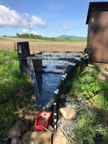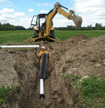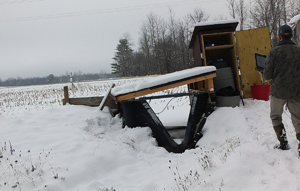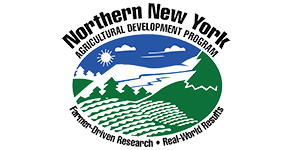
Keeseville, New York; March 28, 2022. The movement of water and the nutrients it carries over and through soil is a complex process. To understand how the use of tile drainage influences that process, the farmer-driven Northern New York Agricultural Development Program (NNYADP) and Miner Institute are collaborating on agricultural nutrient transport and water quality research of interest to conservationists and farmers locally, statewide, and nationally. The latest results of two projects collecting data year-round from side-by-side trials of tile-drained and undrained fields on a working farm are now posted at https://nnyagdev.org/index.php/2021-nnyadp-projects/.
“The farmers who guide the Northern New York Agricultural Development Program prioritized the development of a real-world, data-based foundation for creating and refining best management conservation and agricultural guidelines that can work in tandem to protect both water quality and crop production success,” said NNYADP Co-Chair Jon Greenwood, a dairy farmer in Canton, New York, in St. Lawrence County.
 This research began with land provided by the New York State Department of Environmental Conservation; it has now evolved to trials under northern New York growing conditions on a working farm to provide real-time information on how nutrients move in undrained and tile-drained fields.
This research began with land provided by the New York State Department of Environmental Conservation; it has now evolved to trials under northern New York growing conditions on a working farm to provide real-time information on how nutrients move in undrained and tile-drained fields.
Laura Klaiber, a nutrient management researcher with Miner Institute, Chazy, New York, is the project leader. She has presented the progressive, detailed data collected during this research at regional, state, and national conferences of farmers, soil and crop scientists, agronomists, soil health specialists, and natural resource conservation and management professionals.
“The tiling of farm fields has received heightened scrutiny along Lake Champlain and watersheds throughout the nation due to concerns about how it may influence the amount of runoff and the levels of nutrients such as phosphorus or nitrogen that could be transported into nearby waters,” said Klaiber.
Klaiber is collecting surface runoff and tile drainage water samples and analyzing them for nutrient removal rates alongside field production data that measures fertilization and crop uptake of nitrogen and other nutrients.

She notes that there has been very little research nationwide that has focused on identifying the potential impact on water quality that may occur when the primary pathway of runoff changes from the surface to belowground.
“With these trials in northern New York, we now have data with promising and important implications for phosphorus reduction efforts; however, we need to better understand the connected processes associated with increased risk for nitrogen mobilization,” Klaiber explained.
The influence of changing weather patterns, extreme weather events, and farm management practices for such tasks as planting and harvesting are also part of Klaiber’s project work.
“With a changing climate and more frequent extreme weather events, growing conditions for farmers are now more challenging than ever. Research is critical to provide guidance that our farmers can use to adapt to these challenges and continue to grow high quality crops in a manner that also preserves our natural resources,” Klaiber noted.
 Funding for the Northern New York Agricultural Development Program is supported by the New York State Legislature and administered by the New York State Department of Agriculture and Markets.
Funding for the Northern New York Agricultural Development Program is supported by the New York State Legislature and administered by the New York State Department of Agriculture and Markets.